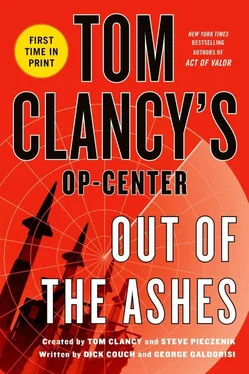“Enough time has passed,” the prince said. “Neutralize the site and let me know when you have completed your work.”
“Yes, we will do it immediately.”
Makhdoom rousted his men, shouting, “That was Prince Ali. Neutralize the site now. Let’s get moving.”
There was a frenzy of activity as his men swung into action. They had practiced this and they knew their roles. No other orders needed to be given.
Ali al-Wandi’s call to the Saudi Embassy in Washington the day before had not been to some bureaucrat or minor diplomat. He had spoken with the man in the embassy who held the science and technology portfolio. He paid him enough to be responsive to his calls.
That man had served in the embassy for a number of years. As the S&T expert he had been instrumental in brokering the US$60 billion deal in 2011 in which the United States sold the Saudis platforms and weapons they sorely needed, many of them representing the cutting edge of American military technology.
The United States, and especially American defense contractors, had been eager to close this deal with the Saudis and had granted this man unusual access and information regarding the capabilities of key U.S. military technology. This Saudi was lavish with his gifts to important officials at some of the biggest defense contractors. They, in turn, had granted him unprecedented entree. The man often boasted, and with good reason, he knew the specifications of the best U.S. military equipment better than high-ranking generals and admirals did.
What Ali al-Wandi wanted to know, and what the man had readily delivered, was how long it would take the U.S. military to rush other overhead assets to the Gulf to confirm what Global Hawk Two Bravo had seen in the Syrian desert. He also wanted to know how long it would take the United States to redirect one of the military’s satellites to peer down on the site.
Once he had his answer, al-Wandi had calculated how long he could leave his missile site in place before what Global Hawk Two Bravo was seeing was contradicted by another overhead asset. He knew how long it would take his men to disassemble and cover up the DF-21D missile site, added a few hours fudge factor just in case, and made the call to his chief engineer.
Now, minutes after his call, Jawad Makhdoom had his men disassembling the dummy missiles and fake missile launchers and putting them into the low-slung blockhouse. They then covered the blockhouse with roll after roll of camouflage netting and then for good measure used powerful blowers to blow sand over the blockhouse.
“What do you think?” his number two man asked Makhdoom.
“I think we’ve got it covered pretty well. Standing here, and maybe looking down from a few thousand feet, you can still tell something is here, but from the altitude the Global Hawk flies, it will just look like sand.”
“Are we going to stop hacking the Global Hawk’s sensors now?”
“Already done, and at the precise time we calculated.”
“Then why does Prince Ali want us to stay here,” the man asked. “Isn’t our work over?”
“My friend, we must never question the prince. He may want us to activate the site again, and while it is true I don’t need all of you here while I do this, the prince has instructed me to start playing the tapes he has prepared. For now, we wait.”
“Tapes?” the man asked.
“Yes, tapes of some constructed conversations we want the Americans to overhear, but I’ve told you enough already. The prince doesn’t want this information generally known.”
The man feigned ignorance, but living in the tight quarters of the blockhouse, there really were no secrets. The prince had paid someone to tape conversations that sounded as if they were coming from the Syrian army high command. The ominous-sounding exchanges were designed to make the Americans think Syria had multiple DF-21D sites in its vast desert and that it was on the verge of launching her DF-21D missiles at U.S. Navy ships in the Gulf.
“All right then,” the man replied, “but can we burn the Syrian army uniforms we have been wearing? The men are still angry they were made to wear them when they were outside the blockhouse.”
“Not yet. Not yet.”
* * *
On board Normandy, Laurie Phillips knew she hadn’t done everything she needed to do, but she was on a mission to do just that. She had mustered the gumption to take her roommate’s advice and go see Normandy ’s ops officer and relate her concerns to him. Now, ten minutes after knocking on his stateroom door and having him listen to her worries about the video, she waited for Neil Watson to reply to her almost nonstop story.
“Ms. Phillips, you’ve explained what you’ve observed and related your suspicions. I’ve got to tell you, this is a lot to absorb. And you say you’ve shared this with some of my folks in CDC, and no one has a really strong take on this either way?”
“I think that about sums it up, Commander. I’m just not sure, but I am concerned something’s not just right.”
“All right then, we need to take this to the captain. He’ll make the call.”
* * *
“Captain, a moment?” Neil Watson asked as he appeared at the doorway of the captain’s at-sea cabin with Laurie Phillips in tow.
“Sure, Ops O, what you got?”
“Captain, well, it concerns the Global Hawk video showing that DF-21D missile site in Syria. Ms. Phillips has some concerns she shared with me and we wanted to bring them to your attention.”
That wasn’t the affirming introduction Laurie was looking for, but it would have to do.
“Concerns, Ms. Phillips?”
“Yes, Captain,” Laurie began, trying to be as respectful and diplomatic as possible. She certainly hadn’t rehearsed this, and if she had she might not have had the courage to say anything at all.
“Captain, we have looked repeatedly at the Global Hawk video, or I should say I have, and well, sir, it appears this video may not be what we think it is. What I mean is, well … it could be presenting false information, and since it is information that seems to be sending the strike group into overdrive, we should give it a second look.” This wasn’t coming out precisely the way Laurie wanted it to. She tried to regroup. “Sir, I’ve looked at the video many times, and there appear to be some issues with the location of what it is taking pictures of. I mean to say, sir, well, it doesn’t seem that based on the scenes shot earlier in the flight and the scenes shot later in the flight that the location of the DF-21D missile site is where this video is saying that it is.”
Laurie tried to keep eye contact with Blackman as her words poured out, but occasionally she also cast a furtive glance at Neil Watson for support. However, the ops officer just looked at his shoes.
“In any event, Captain,” Laurie continued, “since it appears the evidence we have against Syria is based solely on this video, perhaps we ought to tell our leaders there might be some issues with it.” Laurie mentally kicked herself for letting her voice trail off a bit as she finished her last sentence.
Captain Blackman stared at Laurie as if he had been shot.
“Well, Ms. Phillips,” Blackman began, “thank you for that … that … what is it you told us you came here to do?… that analysis .”
“Yes, sir, Captain. Not analysis, not yet, anyway, just a suspicion.”
“Do any of my other professionals in CDC share your suspicions? Mr. Watson, do they?”
“Well, not really, Captain; we wanted to tell you first.”
Laurie jumped in. “Captain, the point is there appears to be so much riding on this video, maybe even us attacking Syria, that I just think we ought to take a better look at this before acting.”
Читать дальше












